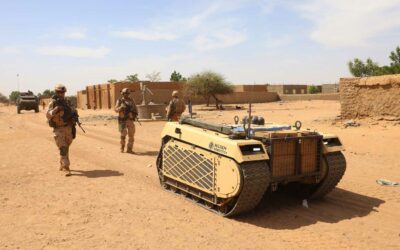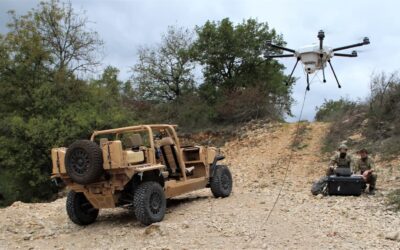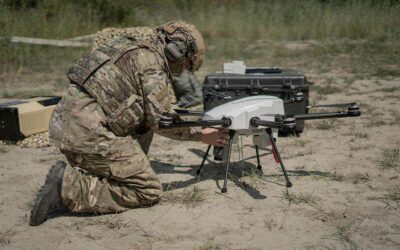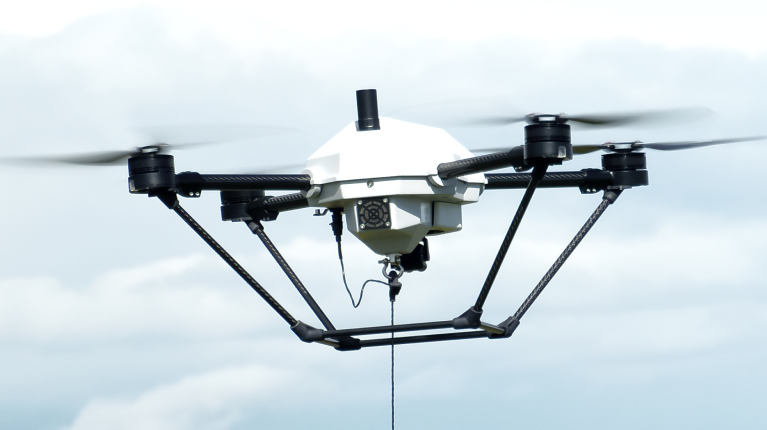Rethinking Recon: How Tethered UAV Change ISR Doctrine
L'équipe Elistair
5 minutes
Modern military operations are defined by the need for persistent intelligence, surveillance, and reconnaissance (ISR) even in highly contested environments. Traditional ISR assets – from satellites to untethered drones – provide invaluable data but face limitations in endurance, electromagnetic warfare resilience, and risk exposure to enemy defenses.
In this context, tethered unmanned aerial vehicles (UAVs) are emerging as a persistent “eye in the sky” ISR assets that can transform doctrine for NATO, U.S., European and Allied forces.
Unlike free-flying drones, a tethered UAV remains connected to ground power and communication source via an ultralight cable, enabling it to stay aloft for extended durations while maintaining a secure data link. This technology offers a continuously available overwatch capability that is akin to a rapidly deployable surveillance tower, but with the mobility and flexibility demanded by modern operations.
Military and border security professionals are increasingly integrating tethered UAVs into their concepts of operation, recognizing their value in long-duration ISR, communications relay, and force protection missions.
The following analysis outlines how tethered drones fit into contemporary ISR doctrine, highlighting key use cases – from forward base protection to convoy escort and border surveillance – and drawing lessons from recent conflicts like Ukraine. We also provide doctrinal recommendations for commanders and ISR planners to fully leverage these systems in future operations.
Persistent ISR from Tethered “Eye in the Sky”
Tethered UAVs serve as persistent ISR assets that can hover over a designated area for hours or even days, far exceeding the endurance of battery-powered drones. With power supplied through the tether, these platforms can maintain continuous day/night surveillance coverage without the need for frequent landings or battery swaps.
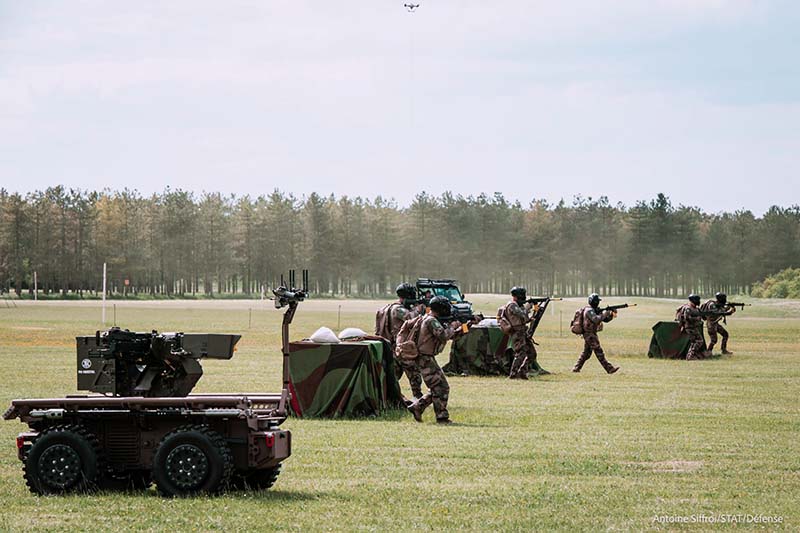
For example, current tactical tethered drones can remain airborne for over 24 hours, providing an uninterrupted stream of video and sensor data to operators on the ground. A tethered UAV becomes a relocatable surveillance tower, elevating cameras and other sensors to gain a clear line of sight over terrain and structures.
This persistent overwatch is particularly valuable for missions that demand constant vigilance, such as guarding a forward operating base or monitoring a border crossing.
Crucially, tethered UAVs contribute to force protection and situational awareness without risking manned aircraft or exposing larger UAVs to enemy fire. By operating at relatively low altitudes (typically tether lengths of 50–100 meters) and small physical size, they present a minimal visual signature to the enemy, allowing covert or semi-covert ISR in forward areas.
Commanders can thus obtain continuous intelligence on threats while keeping higher-value assets out of harm’s way. In essence, tethered drones fill the gap between ground sensors and high-flying ISR platforms: they extend the sensor viewpoint above what ground patrols or fixed cameras can see yet remain discreet. This combination of persistence and stealthy profile is reshaping reconnaissance tactics at the tactical edge.
Integration of tethered UAV systems into NATO and U.S. ISR Doctrine
Doctrinal Acceptance: Tethered UAVs are no longer experimental; they are steadily entering the inventories and doctrines of NATO armies and partner forces. Systems of this class have been deployed by militaries and security forces in dozens of countries worldwide, including leading NATO members.
Within NATO’s Joint ISR frameworks and the U.S. Army’s multi-domain operations doctrine, tethered UAVs are viewed as organic ISR and communications nodes that can operate at the tactical level while feeding into the larger intelligence network.
U.S. Army Integration
The U.S. Army has been actively exploring tethered drones for roles in contested environments, to provide persistent overwatch for armored and mechanized units, leveraging the drones’ wired power supply to remain aloft far longer than battery-powered systems.
The Army aims to move these systems from concept to programs of record: a senior Army capability lead noted in 2024 that small tethered drones could soon become formal gear for armored units, while infantry platoons employ other unmanned systems. This integration is driven by operational lessons – for example, that armored and mechanized forces on the move benefit from having an organically controlled aerial ISR asset constantly observing their flanks and beyond the next terrain feature, something a tethered drone on a vehicle can provide.
The U.S. Army’s requirements for tethered UAV systems underscore their doctrinal importance. In a 2024 request for industry proposals, Army researchers outlined the need for a covert, vehicle-integrated tethered UAV to extend line-of-sight ISR and act as a communications relay inside enemy territory.
This tethered UAV must support the Army’s modular open systems approach and be capable of teaming with crewed or uncrewed vehicles. Notably, the Army specified that the system should have reduced signatures and enhanced concealment, along with extended endurance, to survive in contested airspace. The tether connecting the drone to its base station is envisioned not only as a power conduit but as a high-bandwidth data link – effectively a fiber-optic cable – carrying control signals and sensor feeds with minimal electromagnetic emissions.
By keeping communications along the tether, the drone would avoid acting as a radio frequency (RF) emitter, thus remaining difficult for the enemy to detect or jam. The Army also requires these systems to function in GPS-denied conditions and rough weather, reflecting expectations that future conflicts will involve heavy jamming and challenging environments.
In sum, U.S. doctrinal development envisions tethered drones as organic ISR assets for combat brigades, enhancing situational awareness under the safety of armored protection and within a robust, secure network architecture.
NATO and European Perspectives
European militaries similarly recognize the value of tethered ISR. NATO allies have begun integrating tethered drones into exercises and force structure for both domestic security and expeditionary missions. A recent German Army trial, for example, demonstrated a tethered drone from Elistair teamed with an unmanned ground vehicle to provide mobile ISR support without interruption.
During this three-week evaluation, the tethered drone system (deployed from a “dronebox” on the vehicle) maintained continuous surveillance as the vehicle maneuvered, showcasing how mobile units might carry their own tethered “watchtower” into the field. Insights from such NATO member experiments feed into allied doctrine, emphasizing that continuous, autonomous surveillance across large areas is achievable by pairing ground vehicles with tethered aerial sensors.
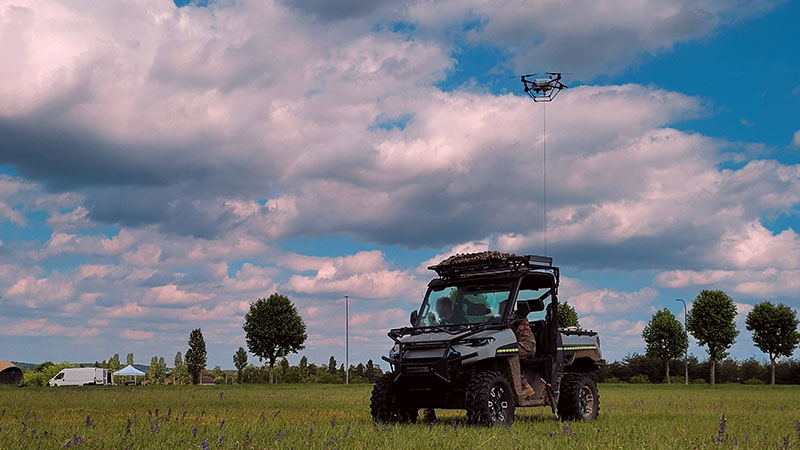
European border security agencies and peacekeeping forces are also deploying tethered drones for persistent observation tasks. The French armed forces and other European militaries have fielded Elistair tethered UAV systems for base protection and border monitoring, often procuring them as turnkey solutions that can be rapidly integrated into existing command and control systems. NATO’s broader ISR strategy, which values a resilient sensor network, is well-served by tethered drones that can plug into coalition networks and share real-time video feeds securely with allied units.
Overall, the integration of tethered UAVs into Western military doctrine is centered on enhancing persistent situational awareness and communication in the lower tier of the battlespace.
By filling this niche, tethered drones allow high-end assets (like satellites, manned ISR aircraft, or large UAVs) to focus on other areas, while front-line units gain greater self-sufficiency in intelligence gathering. The doctrinal shift is to treat tethered UAVs as organic extensions of ground units – much like an additional sensor mast or tower that can deploy on demand – and to incorporate their presence in operational planning, training, and force design.
Lessons from Ukraine: Electronic Warfare and GPS Denial
Recent conflicts, especially the war in Ukraine, have underscored the importance of resilient ISR in the face of electronic warfare (EW). In Ukraine’s drone-filled battlespace, both Russian and Ukrainian forces have aggressively employed jamming and spoofing tactics to disable or hijack unmanned aircraft. Standard quadcopters and uncrewed systems that rely on radio-frequency control links or GPS signals often fall prey to these EW measures.
Resisting hostile electromagnetic conditions
This conflict has effectively become a proving ground for tethered or wired drone concepts that can sidestep the vulnerabilities of wireless communications. Notably, both sides have begun deploying drones connected via fiber-optic tethers – sometimes dubbed “invisible drones” – which use a thin optical fiber rather than radio waves for control and data.
These fiber-tethered UAVs are immune to radio jamming and largely undetectable by RF sensors, since they emit no telltale radio signals. The tether not only provides power for long endurance, but also a secure communication link that cannot be intercepted or jammed through conventional means.
Such battlefield improvisations affirm the value of tethered systems for militaries facing near-peer adversaries. In a dense EW environment, a tethered drone can continue operating where an ordinary radio-controlled drone would be rendered useless.
Even if GPS navigation is denied by jammers, a tethered UAV can maintain its position and stability through inertial systems and the physical constraint of the tether, or by receiving positioning data via the tether from the ground station.
Indeed, modern tethered drone designs explicitly advertise operations in GPS/GNSS-denied and RF-denied environments as a core feature, using advanced onboard algorithms to localize and hover without satellite aid. From a doctrinal standpoint, this means commanders can count on tethered ISR assets to remain functional in the most hostile electromagnetic conditions – a significant reliability factor when planning ISR for high-intensity conflict.
Securing tactical ISR nodes
Another lesson from Ukraine is the tactical survivability of tethered drones in contested airspace. While a tethered UAV is generally confined to a specific radius by its cable, this very limitation can be a protective strength. Units in Ukraine have learned to keep drones closer and lower to avoid long-range air defenses; a tethered drone inherently operates just above friendly forces, often below the line-of-sight of enemy radar or beyond the effective range of anti-drone weapons.
These factors make tethered UAVs hard targets for enemy EW and intercept, especially when compared to larger, farther-ranging drones that must transmit over the air. Commanders and ISR planners observing these developments are adapting doctrine to emphasize electronic protection: tethered UAVs are seen as highly secure ISR nodes ideal for environments where communications and GPS are heavily contested.
The advent of tethered UAV technology is compelling military and security professionals to rethink traditional reconnaissance doctrine. These systems offer a blend of persistence, reliability, and security that addresses several gaps in current ISR capabilities. Whether it is an Army unit securing a forward base under constant threat, a convoy navigating uncertain roads, or a border guard monitoring a long frontier, tethered drones provide a steady watchful presence that enhances situational awareness and force protection.
Their successful use in recent conflicts – surviving intense electronic warfare and maintaining surveillance where others faltered – highlights that tethered UAVs are not just convenient tools but critical enablers in contested operations. Modern NATO and coalition doctrines are gradually absorbing this reality, updating their ISR practices to include tethered assets as key components in a multi-layered surveillance strategy.
PART II – Operational Use cases for tethered ISR systems, and Recommendations for Commanders and Planners
Click here to read the second part of this article: https://elistair.com/articles/tethered-uav-systems-use-cases-and-recommandations/
The analysis above integrates information from current defense research and field reports, including U.S. Army program documents, NATO trials, and expert commentary on drone warfare in Ukraine. These sources underline the growing consensus that tethered UAVs are reshaping ISR practices for allied forces worldwide.

